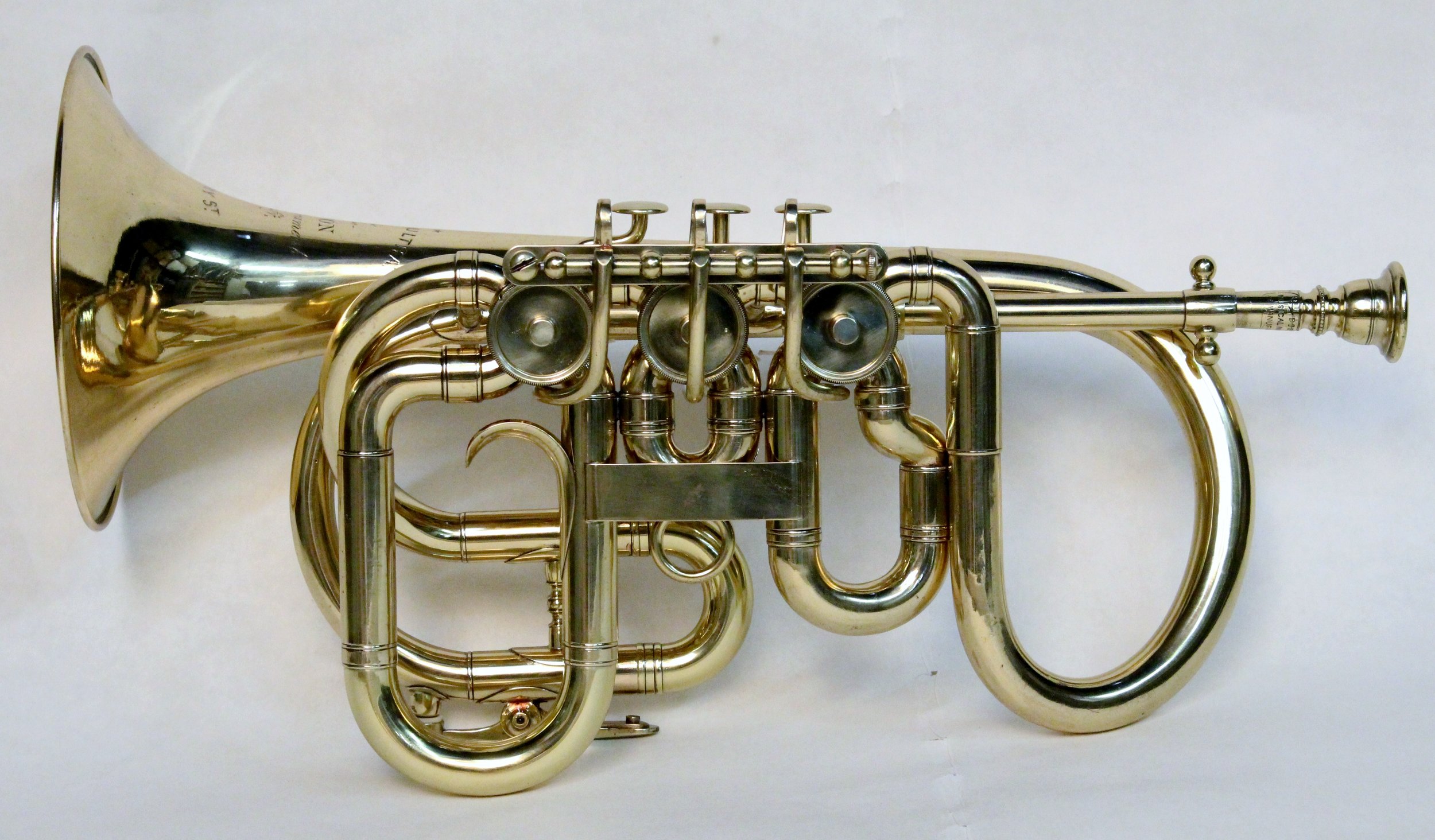Esbach's Patent Cornet Model, ca. 1878
This is the earliest known example of Henry Esbach's 1879 Patent Three Star Cornet. This statement is made based on the fact that it appears identical to the patent drawing but different than all other known examples and the engraved image from Boston catalogues. All the later examples (eight known) have the patent date engraved on the plate that extends between the first and third valve slide tubes. These few facts can also lead one to speculate that this is the prototype that was available to the draftsman who made the patent drawing. The fact that this cornet never had a lyre mount installed also points to the likelihood that it is the actual prototype.
Click on images for larger views.
This is also one of the very earliest of any Boston Three Star Cornets known, probably made in 1878. All seven of the Esbach models known are also early Three Star models, with no serial numbers. Interestingly, three of those are pitched primarily in C with tuning slides for Bb. These variants have smaller bores (.463" compared with .487" in the Bb) and smaller bells as found in the earlier piston valve cornets and the rotary valve Band and Orchestra Model cornets. I don't know of any piston valve Boston Three Star Model cornets that are primarily pitched in C, although a number of them have C attachments to bypass the Bb mouthpipes and valve slides short enough for playing in C. I present the facts as best I know on pages describing the origins of the Boston cornets and the introduction of the Three Star models.
Larry Minick restored this cornet for a previous owner in the 1970s but unfortunately, it suffered harsh treatment subsequently. It is 12 1/8" long with bell diameter of 5" and bore diameter measuring .487". In the image below, you can see that this is the same cornet as depicted in the patent drawings.
Here's an interesting anecdote: During the meeting of about 15 or so cornet collectors and players (a few of which were quite good players) this was judged, almost unanimously, to be the best playing of the many dozens of cornets in the room. In a more recent gathering, we had four of the eight Boston Esbach Patent cornets together for group photographs, seen in the photos below, as well as being used in a brass band concert together. All four of these cornets were judged to be superior playing instruments. The cornet on the far right in the sixth and seventh photos (tarnished silver plating) is the newest of these, having the trademark engraving and intermediate, .472" bore, as seen on all later Three Star Models. The fact that it still doesn’t have a serial number dates it to before about 1882.
The characters holding the cornets in the fifth photo, from left to right, are Chris Belluscio, Nick DeCarlis, Robb Stewart and Dale Olson.
Most recently, another of the nine known instruments, pictured below, came to the shop for restoration from Chris Milligan of Burlington, Ontario. This was his wife's great grandfather, Thomas Michell's cornet when new and the family has a number of photos, taken in the 1880s, of him and other family members holding it.
This is another early Bb Three Star Model version, with the .487" bore, 5" bell rim and no trademark engraving. Like so many brass instruments, long obsolete, it suffered much abuse, as can be seen in the last photo. In spite of this, it is still a very lovely playing cornet, after the extensive restoration. Thomas Michell must have loved this cornet and played it for many years, evidenced by the very deep erosion where the left hand gripped it and the right thumb supported the mouthpipe. In the last photo, you can see that the third slide crook is thoroughly twisted and collapsed. This is largely because of the brass made thin by the fingers of the left hand wrapping around it. It is also remarkable that this instrument has retained almost all of it's original parts. Only one stop arm screw had been replaced in the past and it is missing the A shank, bits and mouthpiece.











